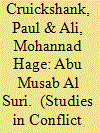|
|
|
Sort Order |
|
|
|
Items / Page
|
|
|
|
|
|
|
| Srl | Item |
| 1 |
ID:
076935


|
|
|
|
|
| Publication |
2007.
|
| Summary/Abstract |
Drawing on new sources, the authors argue that Abu Musab al Suri (real name Mustafa Setmariam Nasar), now in U.S. custody, is the principle architect of Al Qaeda's post-9/11 structure and strategy. His vision, which predated 9/11, of transforming Al Qaeda from a vulnerable hierarchical organization into a resilient decentralized movement, was largely the formula Al Qaeda adopted after the collapse of the Taliban. The authors show how Setmariam, whose ideas have been disseminated widely on the Internet and whose disciples have gravitated to leadership positions in the international jihad, has influenced Al Qaeda's post-9/11 strategy, targeting, and doctrine.
|
|
|
|
|
|
|
|
|
|
|
|
|
|
|
|
| 2 |
ID:
133916


|
|
|
|
|
| Publication |
New Delhi, Penguin Books India Pvt Ltd, 2014.
|
| Description |
xi, 403p.Pbk
|
| Standard Number |
9780241003787
|
|
|
|
|
|
|
|
|
|
|
|
Copies: C:1/I:0,R:0,Q:0
Circulation
| Accession# | Call# | Current Location | Status | Policy | Location |
| 057875 | 923.4/STO 057875 | Main | On Shelf | General | |
|
|
|
|
| 3 |
ID:
110849


|
|
|
|
|
| Publication |
2012.
|
| Summary/Abstract |
Ten years after 9/11, and after the death of Osama bin Laden, this article re-examines the early history of Al Qaeda-from its founding in August 1988 up until bin Laden's declaration of war against the United States in Afghanistan in 1996-by examining the group's aims, operations, alliances, finances, and administration during five distinct phases of the evolution of bin Laden's worldview. The authors argue that in assessing the formative years of bin Laden's organization, it is equally wrong to minimize the ambitions and organization of the early Al Qaeda as it is to telescope back from the Al Qaeda of the 9/11 attacks to argue that the group was organizing itself to wage a global Jihad from its inception. The authors outline how it was only a half decade later-after the group had decamped to Sudan, and after the U.S. had deployed troops in Saudi Arabia and Somalia-that al Qaeda shifted to conceiving its central mission as attacking American targets.
|
|
|
|
|
|
|
|
|
|
|
|
|
|
|
|
|
|
|
|
|